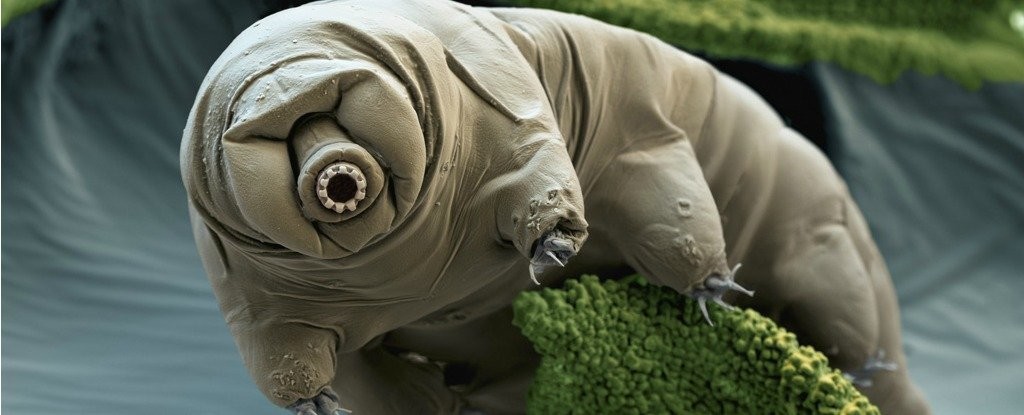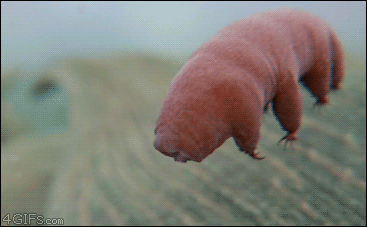The Tardigrade Genome Has Been Sequenced, and It Has the Most Foreign DNA of Any Animal
SCIENCE, 30 Nov 2015
Fiona Macdonald , Science Alert – TRANSCEND Media Service
Water bears just got even weirder.
25 Nov 2015 – Scientists have sequenced the entire genome of the tardigrade, AKA the water bear, for the first time. And it turns out that this weird little creature has the most foreign genes of any animal studied so far – or to put it another way, roughly one-sixth of the tardigrade’s genome was stolen from other species. We have to admit, we’re kinda not surprised.
A little background here for those who aren’t familiar with the strangeness that is the tardigrade – the microscopic water creature grows to just over 1 mm on average, and is the only animal that can survive in the harsh environment of space. It can also withstand temperatures from just above absolute zero to well above the boiling point of water, can cope with ridiculous amounts of pressure and radiation, and can live for more than 10 years without food or water. Basically, it’s nearly impossible to kill, and now scientists have shown that its DNA is just as bizarre as it is.
So what’s foreign DNA and why does it matter that tardigrades have so much of it? The term refers to genes that have come from another organism via a process known as horizontal gene transfer, as opposed to being passed down through traditional reproduction.
Horizontal gene transfer occurs in humans and other animals occasionally, usually as a result of gene swapping with viruses, but to put it into perspective, most animals have less than 1 percent of their genome made up of foreign DNA. Before this, the rotifer – another microscopic water creature – was believed to have the most foreign genes of any animal, with 8 or 9 percent.
But the new research has shown that approximately 6,000 of the tardigrade’s genes come from foreign species, which equates to around 17.5 percent.
“We had no idea that an animal genome could be composed of so much foreign DNA,” said study co-author Bob Goldstein, from the University of North Carolina at Chapel Hill. “We knew many animals acquire foreign genes, but we had no idea that it happens to this degree.”
So where is the tardigrade getting all its genes from? The foreign DNA comes primarily from bacteria, but also from plants, fungi, and Archaea. And it’s this incredible variety of genes that researchers suggest has allowed the water bear to survive in such extreme conditions.
“Animals that can survive extreme stresses may be particularly prone to acquiring foreign genes – and bacterial genes might be better able to withstand stresses than animal ones,” said one of the researchers, Thomas Boothby.
The team hasn’t investigated exactly how this gene-stealing is happening just yet, but they propose that it’s a result of one of the tardigrade’s other crazy survival mechanisms – the ability to dry out until its body is less than 3 percent water, and then come bounce back once they’re rehydrated.
When this desiccation happens, scientists know that their DNA breaks down into tiny pieces. They also know that when their cells rehydrate, there’s a point in time when the cell nucleus is leaky, allowing DNA and other molecules to pass through. That means that while the tardigrade is quickly patching up its own genome, it may accidentally be stitching in another organism’s genes.
This would be a random process, but the genes that get passed down would be those that help the animals survive. Further research now needs to be done into exactly how tardigrades are obtaining this foreign DNA, and how often it’s happening. But what’s really exciting is that it provides new insight into exactly how life evolves.
“We think of the tree of life, with genetic material passing vertically from mom and dad. But with horizontal gene transfer becoming more widely accepted and more well known, at least in certain organisms, it is beginning to change the way we think about evolution and inheritance of genetic material,” said Boothby. “Instead of thinking of the tree of life, we can think about the web of life and genetic material crossing from branch to branch … it’s exciting. We are beginning to adjust our understanding of how evolution works.”
The research, which has been published in PNAS, could also provide some insight into useful genes we could use in medicine and drug development. So long live the water bear, in all its weirdness.
Go to Original – sciencealert.com
DISCLAIMER: The statements, views and opinions expressed in pieces republished here are solely those of the authors and do not necessarily represent those of TMS. In accordance with title 17 U.S.C. section 107, this material is distributed without profit to those who have expressed a prior interest in receiving the included information for research and educational purposes. TMS has no affiliation whatsoever with the originator of this article nor is TMS endorsed or sponsored by the originator. “GO TO ORIGINAL” links are provided as a convenience to our readers and allow for verification of authenticity. However, as originating pages are often updated by their originating host sites, the versions posted may not match the versions our readers view when clicking the “GO TO ORIGINAL” links. This site contains copyrighted material the use of which has not always been specifically authorized by the copyright owner. We are making such material available in our efforts to advance understanding of environmental, political, human rights, economic, democracy, scientific, and social justice issues, etc. We believe this constitutes a ‘fair use’ of any such copyrighted material as provided for in section 107 of the US Copyright Law. In accordance with Title 17 U.S.C. Section 107, the material on this site is distributed without profit to those who have expressed a prior interest in receiving the included information for research and educational purposes. For more information go to: http://www.law.cornell.edu/uscode/17/107.shtml. If you wish to use copyrighted material from this site for purposes of your own that go beyond ‘fair use’, you must obtain permission from the copyright owner.

